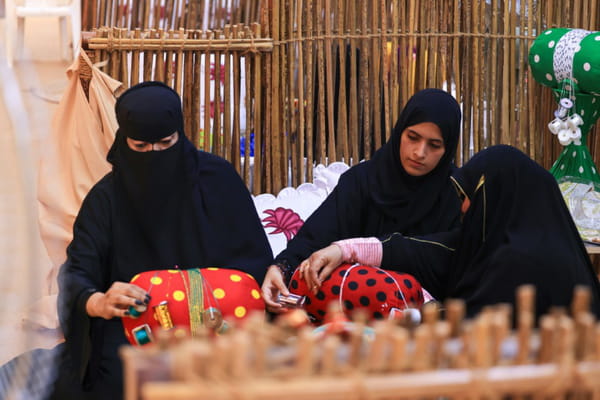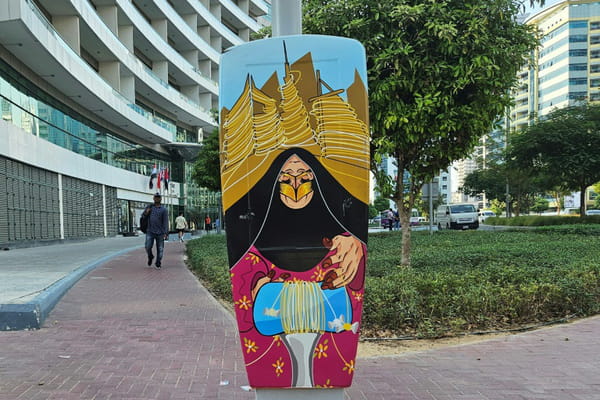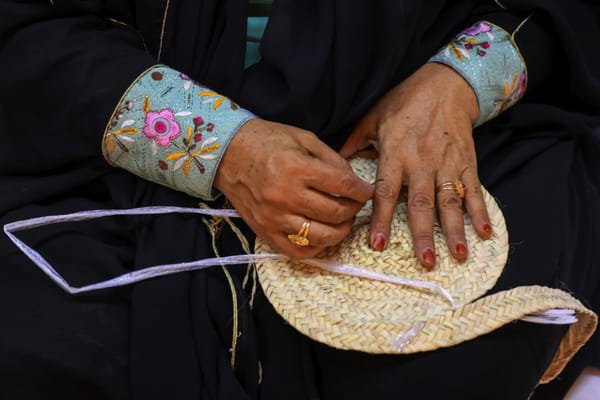Far from the glittering skyscrapers of Dubai, Mariam al-Kalbani introduces a young Emirati woman to life. the art of talli, a traditional embroidery know-how listed as a UNESCO world heritage site, and under threat of disappearance in the Gulf country. Hands tattooed with henna, this septuagenarian braids colored threads, forming patterns that will adorn clothes or bags, under the attentive gaze of a novice who has come to learn the secrets of a laborious practice, passed down from generation to generation. “It is the craft of our grandparents and our parents, and if we do not take the initiative to initiate them, it will disappear,” she explains to AFP, as part of a festival dedicated to local crafts in the Al-Ain region, in the emirate of Abu Dhabi. The face half covered by the typical burqa of the Golfe, a mask in golden fabric, the trainer underlines the complexity of the work which can involve up to fifty different threads. For the simplest patterns, made with six threads, a meter of embroidery requires up to three hours of work. As for learning, “it can take one or two years (…) at the rate of one lesson per week”, explains Mariam al-Kalbani, who has been braiding the talli since adolescence. – Emirati heritage – Inscribed on UNESCO's list of intangible cultural heritage in 2022, talli is practiced in several of the emirates that make up the country, but its origin is difficult to determine, according to Mohammed Hassan Abdelhafez of the Sharjah Heritage Institute. Emirati women weave using the Al Talli method, a traditional local weaving technique, during a festival in Al-Ain, United Arab Emirates, November 10, 2023 © AFP – Karim SAHIB UNESCO's selection criteria, however, require that the know-how has been transmitted over several generations, “at least from grandparents to grandchildren”, he emphasizes. Mariam Al-Kalbani did not succeed in communicating her passion to her children. Only her three-year-old granddaughter likes to watch her braid, she says, and her apprentices like Rim al-Ketbi, who attentively follows her every move. This 23-year-old student acknowledges that women her age are “not very interested” in traditional crafts, but for her, preserving “Emirati heritage is a question of love for the country.” A sign depicting a woman practicing the art of talli, a traditional weaving technique, in Dubai, September 30, 2023 © AFP – Amanda MOUAWAD Once deserted, the United Arab Emirates have experienced a major social and economic transformation over the past fifty years, notably Dubai, an ultra-connected city that has become famous for its disproportionate projects. But the rich oil country, of which 90% of its approximately 10 million inhabitants are now expatriates, has always sought to preserve its traditions and its way of life “even after the onslaught of modernity and the discovery of oil”, underlines Mohammed Hassan Abdelhafez. – “At risk of disappearance” – At the festival of crafts and industries traditions of Al-Ain, the talli is not the only one in the spotlight. In the central square, men perform a dance called Ayalah, brandishing bamboo sticks or unloaded guns, to the rhythm of folk songs. An Emirati woman weaves palm leaves during a heritage festival in Al-Ain, United Arab Emirates, November 10, 2023 © AFP – Karim SAHIB A little further away, women make sadu, a traditional fabric used for tents, carpets and camel saddles, and whose know-how is also on the list of intangible heritage of the Unesco since 2011, while others sell clothing and various items. Abu Dhabi authorities have identified all the artisans to support them and help them to to make itself known to young people, says an official from the emirate's Ministry of Culture and Tourism, Aisha al-Dhaheri. They have also set up training, especially for the talli, “because it is considered threatened with extinction”, she adds. In his shop where bags, bracelets, key rings, and even incense burners are decorated with talli, Kalthoum al-Mansouri regrets that the young girls are occupied by “tablets and phones”. They must take over, says the octogenarian, because “we, how long do we have left to live ?”. All rights of reproduction and representation reserved. © (2024) Agence France-Presse




